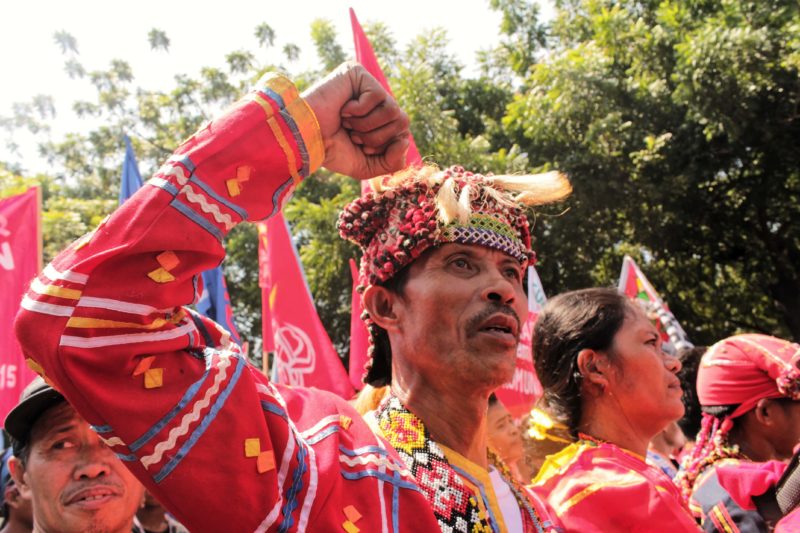It was a brazen and nasty attack.
Three armed men marched into a village in the Philippines region of Mindanao last September and ordered Dionel Campos and his relative, Bello Sinzo, out of their homes. They were activists fighting a new mining operation who remained there with their families in spite of threats. In front of fellow villagers and students at a local school, the two men were executed. Afterward, the gunmen fired their weapons skyward, causing the villagers to scatter.

When the villagers returned, they found a third victim. Emerito Samarca, executive director of the Alternative Learning Centre for Agricultural and Livelihood Development, was dead in a chair with his hands bound, a stab wound to his stomach and his throat slit, local newspapers reported. No arrests have been made.
A report released on Monday by the non-profit watchdog group Global Witness claims that 2015 was the deadliest yet for people who sought to protect their land, forests and rivers from mining, logging and dams. The report, “On Dangerous Ground” called the 185 deaths it uncovered from news reports and public records “shocking,” a nearly 60 percent increase from the previous year, “and the highest annual toll on record.”
“More than three people were killed every week in 2015 — more than double the number of journalists killed in the same period,” the report said.
The most dangerous countries for environmentalists were Brazil, where 50 were slain; the Philippines, where 33 were killed; and Colombia, where 26 people lost their lives. At least 42 slayings were linked to mineral-mining operations, the most among categories that included logging and dam building.
According to said Billy Kyte, the report’s author and a researcher for Global Witness, the toll in other countries could be higher than Brazil’s because the group could only uncover deaths where there was some record of a fatality. In many nations, slayings are not reported. “We think this is the tip of the iceberg,” Kyte said.
As it was the year before, Latin America was the world’s most dangerous region for people trying to protect natural resources in 2015. With the slaying of acclaimed Honduran environmental activist Berta Cáceres Flores in March, along with the killing weeks later of Nelson Garcia, a fellow worker with the Civic Council of Popular and Indigenous Organizations of Honduras (COPINH), 2016 threatens to be worse, Kyte said.
“The environment is emerging as a new human rights battleground,” Kyte said. The reason, he said, that hardly anyone is brought to justice for these crimes is that governments are assisting a broader corporate quest for resources on virgin land, and leaders of indigenous groups are fighting them in remote areas where killers can easily escape or intimidate witnesses.
Nearly 40 percent of those killed were from indigenous groups, Kyte said. “Activists are being repressed the world over in many countries and governments because people know they can get away with it.”
The slain, according to the report, included Rigoberto Lima Choc, a Guatemalan teacher who spoke out against river pollution caused by a palm oil operation. He was shot on the steps of a court building in the town of Sayaxché. Saw Johnny was gunned down by unidentified assailants in the Karen State of Myanmar after advocating for stronger land rights in the state. Alfredo Ernesto Vracko Neuenschwander was shot and killed near his home in Peru’s biodiverse Tambopata region, where he protested a gold mine.
Maria das Dores dos Santos Salvador was kidnapped and killed in August, likely for speaking out against the sale of her community’s land in the rural Amazonas area of Brazil. Sandeep Kothari’s body was found beaten and burned in June after the journalist wrote a critique of sand mining in India’s Balaghat district. Each of the activists, Global Witness said, faced numerous death threats before they were killed and, in the case of Kothari, “intimidation by police.”
After Campos and other villagers were killed in the Philippines, his 17-year-old daughter, Michelle, left school and took up his fight and the cause of finding his killers, placing her own safety at risk. Her mission was duplicated less than a year later when Cáceres’ daughter, Bertha Zúniga Cáceres, abandoned her studies to continue the crusade against the building of a dam and press Honduras to find her mother’s killers.
Cáceres is the most famous of the slain activists, a 2015 winner of the prestigious global Goldman Environmental Prize awarded every year in San Francisco for environmental justice workers. When organisers of the prize sent a video crew to document some of her work, they witnessed a situation so tense and frightening that they feared Cáceres wouldn’t live to receive the recognition in April. They provided her with a grant to beef up her security detail.
Five men, including two brothers suspected of bursting into Cáceres’ home early on March 3 and shooting her as she lay in bed, have been arrested. Family members and environmentalists across the world have condemned the slaying and accused the Honduran government of doing little to seek justice. They charge that there are more culprits than the men who pulled the trigger, and have pushed the government to find anyone who might have helped plan and finance the killers.
This is typical of quests for justice when activists are killed. “They’re just not doing what we think police should do,” said Grahame Russell, director of Rights Action, a non-profit group that funds community development and human rights workers in Guatemala and Honduras. “The state is playing a very specific and direct role in empowering various economic sectors” and looking the other way to move projects along when killings occur, he said.
By Darryl Fears, The Washington Post
